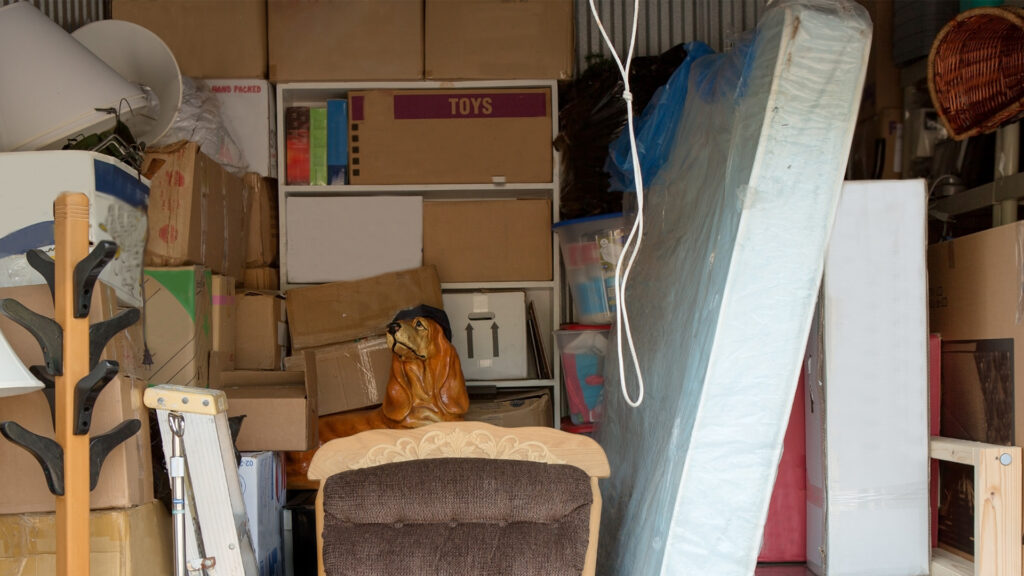
If you’re moving, remodeling your home, or traveling for a long period of time, you may need to put your mattress in storage for a while. Even if you found a great deal on your bed, buying a mattress is an investment that you’ll want to protect while in storage. If stored incorrectly, your mattress could be damaged and will need to be replaced.
We’ve put together an easy-to-follow guide to show you how to store your mattress properly so you can keep it in pristine condition while it is stored away.
How to Store a Mattress
You’ll need to prepare your mattress for storage and then pick the type of storage you’ll be using to keep your mattress safe and sound. We’ve laid out everything you need to know about storing your mattress in the tips below:
Clean the Mattress
Before you put your mattress in storage, you’ll need to get it clean. Mattresses tend to absorb sweat, dust mites, and other allergens as you sleep over the years. If you put a mattress in storage before cleaning it, this build up in your bed can create health risks by turning into mildew and mold.
- First, you’ll need to strip the sheets and mattress pads, toppers, or covers off your mattress.
- Next, it’s time to scrub down your mattress. You could pay for professional cleaning, but you also could clean your mattress using non-toxic cleaning supplies that you may already have in your pantry.
- If you choose to clean your bed at home, start by running your vacuum over the top of the mattress to pick up any dust or hair on the bed.
- Next, sprinkle baking soda all over your bed, use a brush to scrub it into the surface of the mattress, then let it sit for at least 10 minutes before vacuuming your bed again.
For more cleaning tips and instructions on how to get stains out of your mattress, check out our mattress cleaning guide. No matter how you choose to wash your mattress, it is crucial you get it as clean as you can before putting it in storage.
Protect the Mattress
When in storage, you’ll want to keep your mattress protected from bugs, dust, mildew, and other allergens that can get absorbed into your mattress over time. To do this, you’ll want to wrap your mattress up. A mattress bag is a great way to keep your mattress in good shape while in storage. These thin plastic wraps are designed to be breathable to prevent mildew while also keeping contaminants away from your bed. You can order them online or pick them up at local hardware stores, or sometimes at storage unit facilities.
If you don’t have a mattress bag, you could also use a mattress box, sheets, or towels to wrap up your bed, but you may want to cover the entire bed in plastic wrap and seal it tightly with duct tape to keep dust and moisture out of your mattress.
If your bed will be in storage for a long time, it is a good idea to take it out of storage and air it out every few months. Storage facilities can be dark and damp, so this will help prevent moisture from building up in the bed over time.
Mattress Storage Options
Now that your mattress is spick and span and all wrapped up, it’s time to find a place to store your bed.
Storage Unit
Storage units are a safe and secure way to store your mattress — especially if you can find a temperature-controlled facility. Some mattress materials will expand and contract, which compromises the level of support when temperatures change, so a climate-controlled storage unit will help keep your mattress in the same shape as when you put it away. Just keep in mind you may need to rent a truck to get your mattress safely to the storage unit.
At Home
If a storage unit isn’t convenient or in your budget — you can store your bed at home. If you can, try to keep your mattress in a spare bedroom, finished basement, or another temperature-controlled area of the house. If you don’t have space in those areas of the house, you could also store your mattress in the garage or attic.
Since these areas of the house aren’t climate-controlled, make sure to clean your mattress well and wrap it securely before storing. If that area of your house tends to get damp, consider getting a dehumidifier to reduce the risk of mildew. Take a look at our roundup of the best dehumidifiers to find one within your budget.
Storing Your Mattress
When you’ve decided where to store your mattress, you’ll want to position it correctly. Lay the mattress flat and don’t place anything on top of it. Storing your mattress vertically or diagonally and putting other storage items on top of it can cause premature sagging and structural issues in your bed. If you don’t have space to lay the bed down horizontally, then store it on its side but make sure to rotate it every few months so it can evenly distribute the pressure along the bed.
If you can, lay your mattress on a bed frame, wood palette, or other item that can keep it lifted off the ground. This will help keep the mattress clean and help moisture evaporate from the bed to prevent moisture and mildew from being trapped inside. Also, try to visit your storage unit every few months to air out your bed to keep it fresh.
You’ll also want to keep in mind that each individual mattress type also has a different set of needs when in storage:
Storing a Memory Foam Mattress
It’s easier to move memory foam beds around since they don’t have metal layers inside. You’ll be able to roll or fold your mattress to fit it in your car for a short trip to the storage facility without worrying about permanently damaging the materials inside. Soft and malleable memory foam, however, is prone to losing its shape when in storage — which will compromise the level of support when you take it out. Make sure to keep your bed completely flat on the ground — laying your bed on top of lumps and bumps can cause dents in the shape of your bed. Also, leaving anything on top of your bed could create permanent craters in the mattress surface.
Your memory foam mattress will need to be completely dry and wrapped tightly before you put it in storage to prevent the porous foam from soaking up moisture. Also, if you haven’t opened your bed-in-a-box mattress, you can typically leave it in the original packaging for a few months (but double check with the manufacturer for exactly how long it can remain unboxed).
Storing an Innerspring Mattress
Innerspring mattresses are built with layers of metal innerspring coils, which makes them more difficult to transport — but they hold up better overall once in storage. You’ll need to be cautious not to bend your bed while moving it. Bending or folding your innerspring bed can destroy the coils inside, which will make for an uncomfortable sleeping experience once you pull your bed out of storage.
Once you’ve wrapped up your innerspring bed and transported it safely to your storage location, the hardest part is over. The strong steel core of these beds makes them sturdier than their foam counterparts, so you can store them on their sides temporarily without risking too much damage to the mattress.
Storing a Hybrid Mattress
Most hybrid mattresses are built with a blend of springs and coil layers. This makes them sturdier than foam beds, but you’ll still want to store your hybrid bed flat on the ground if possible to help preserve the foam layers in the bed. Also, these mattresses tend to be more flexible than old school innerspring models, but you still don’t want to bend them for long periods of time or else the coils can get damaged.
Taking Your Mattress out of Storage
When you take your mattress out of storage, make sure to air it out in the sun or a well-ventilated area. Once it’s dry, you’ll want to clean it again before you bring it into your bedroom to get rid of any allergens or stale smells it may have picked up while it was in storage.
You shouldn’t have any issues if you prepared and stored it properly, but you’ll want to make sure your bed is in good condition before moving it into your house again. Examine your bed for signs of damage, such as bumps or craters in the surface, mildew, or new stains. If your mattress is looking good, go ahead and put it in a protective mattress cover and put it in your bedroom. If it’s looking worse for wear, you may want to replace your mattress.
FAQs
How do you store a mattress not in use?
Clean your mattress thoroughly, wrap it in a mattress bag or plastic wrap, then place it laying flat on the ground in a temperature-controlled room. Make sure not to store boxes or other objects on top of your bed.
Is it okay to store a mattress on its side?
It is not recommended to store a mattress on its side. Keeping a mattress on one side will cause the inner materials to shift towards the bottom of the bed, which will negatively impact the comfort level and level of support when you take it out of storage.
Should you store a mattress upright?
You should not store a mattress upright. Gravity can pull the inner support layers of the mattress out of alignment, which could damage the mattress.
Is it okay to stack mattresses for storage?
You can stack mattresses for storage. Just make sure not to put boxes or other objects on top of the stacked mattresses.
How long can you store a compressed mattress?
You can usually store an unopened, compressed mattress for up to two months. If you keep it in a compressed state longer than that, you’ll risk damaging the bed. However, it varies by specific bed, so we recommend checking with the mattress manufacturer.
Can you store a mattress folded?
We do not recommend that you store your mattress folded. It is okay to temporarily fold a memory foam bed during transport, but keeping a mattress folded for a long period of time can permanently damage the structure of your bed.
Conclusion
Storing your mattress in the wrong conditions can damage your bed, but If you clean, protect, and properly store your mattress, you should be able to put your mattress in and out of storage without any issues. If you take your bed out of storage and decide it’s no longer the right mattress for you — don’t stress. There are lots of options available for every sleeping position and budget. We can help you find them for your unique sleeping preferences. Need help finding your next new bed? Check out our guide to the top-reviewed best mattresses of the year.



























